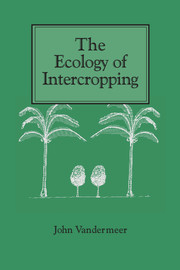Book contents
- Frontmatter
- Contents
- Preface
- 1 Introduction: intercrops and ecology
- 2 The measurement of intercrop performance
- 3 The competitive production principle
- 4 Facilitation
- 5 Mechanisms of the competitive production principle
- 6 The environments modified to produce facilitation
- 7 Special problems in intercrops involving perennials
- 8 Weeds and intercrops
- 9 Variability and intercrops
- 10 Planning intercrops – a phenomenological approach
- 11 Planning intercrops – a mechanistic approach
- 12 Critical research directions for the future
- References
- Author index
- Subject index
1 - Introduction: intercrops and ecology
Published online by Cambridge University Press: 05 August 2012
- Frontmatter
- Contents
- Preface
- 1 Introduction: intercrops and ecology
- 2 The measurement of intercrop performance
- 3 The competitive production principle
- 4 Facilitation
- 5 Mechanisms of the competitive production principle
- 6 The environments modified to produce facilitation
- 7 Special problems in intercrops involving perennials
- 8 Weeds and intercrops
- 9 Variability and intercrops
- 10 Planning intercrops – a phenomenological approach
- 11 Planning intercrops – a mechanistic approach
- 12 Critical research directions for the future
- References
- Author index
- Subject index
Summary
Tropical travelers, from Darwin to my mother-in-law, will attest to the obvious fact that intercrops, two or more crops grown in association with one another, are common. My own travels in India, South-East Asia, and Latin America certainly offer no contradiction to this general rule. Quantitative estimates suggest that 98% of the cowpeas grown in Africa are intercropped (Arnon, 1972), 90% of the beans in Colombia are intercropped (Gutierrez et al., 1975), and the percentage of cropped land in the tropics actually devoted to intercropping varies from a low of 17% for India (Srivastava, 1972) to a high of 94% in Malawi (Edje, 1979). Apparently, in El Salvador it used to be impossible to find sorghum not intercropped with maize (Alas, 1974, cited in Pinchinat et al., 1976; Hawkins, 1984). Even in temperate North America, before the widespread use of modern varieties and mechanization, intercropping was apparently common (e.g. 57% of the soybean acreage in Ohio was grown in combination with maize in 1923 (Thatcher, 1925), and recently there seems to be increased interest in the subject, at least in the research community (e.g. Schultz et al., 1982; Putnam et al., 1985; Herbert et al., 1984; Allen & Obura, 1983; Shackel & Hall, 1984). Thus, by any standard, intercropped agroecosystems are common. Their diversity and overall distribution are illustrated in a partial compilation of combinations that have been cited in the literature, as presented in Table 1.1.
- Type
- Chapter
- Information
- The Ecology of Intercropping , pp. 1 - 14Publisher: Cambridge University PressPrint publication year: 1989
- 1
- Cited by



